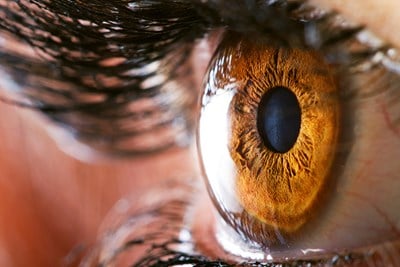Night blindness, or nyctalopia, is a problem with vision, specifically at night or in darkness. In most cases, night blindness is a symptom of something else -- generally an untreated eye problem. Here’s a look at understanding how the eye works, and the causes and treatments of night blindness.
Understanding the Eye
The eyeball is made of many interworking parts; sight has much to do with the way the eye receives and translates light. The cornea is the clear, protective layer across the front of the eye. Its shape helps send light through the eye in a particular way. Basically, it bends rays of light so they go through the pupil -- the dark center of the colored iris that dilates depending on how much light there is in a given environment and focal point (in a brightly light room, the pupils contract because they don’t have to take in as much light, while on a dark night they become very wide in an attempt to take in as much light as possible so the eye can see more).
From there, rays pass through the crystalline lens and vitreous substance (the jelly-like fluid that fills the eyeball), and onto the retina. The retina is one of the back layers of the eyeball, composed of photosensitive cells called rods and cones. At the retina, the rays are turned into impulses and sent to the optic nerve, which transfers them to the parts of the brain responsible for making sense of all the impulses and creating an image.
Causes of Night Blindness
Night blindness can be a symptom of several different eye problems. It can be a warning sign of cataracts, a condition in which the normally clear outer lens becomes cloudy, interfering with vision externally. Glaucoma, a variety of disorders in which the optic nerve is damaged, can also cause night blindness from an internal issue, as opposed to cataracts.
Additionally, some medications for glaucoma make the pupil stay tiny, which obviously makes viewing in the darkness much more difficult, as sufficient light cannot pass through the pupil. Retinitis pigmentosa (RP) are inherited eye disorders in which the rods and cones begin to die, causing blindness over time. Keratoconus is an eye disorder in which the cornea is abnormally shaped. Light doesn’t enter at the correct angles, preventing the retina from having a single focal point, making everything blurry and night vision especially difficult.
Nearsightedness, or myopia, a condition often requiring corrective lenses because you can’t see clearly far away, can also result in night blindness if left untreated. Diabetic retinopathy is a direct result of diabetes in which microaneurysms or abnormally forming blood vessels can interfere with the retina’s visual abilities, severely inhibiting sight. Essentially, night blindness frequently occurs in most eye conditions that can result in blindness or vision loss, particularly those that directly interfere with parts of the eye integral to angling or interpreting light.
Treatment for Night Blindness
Sometimes, night blindness is treatable. For example, cataract surgery, in which the cloudy lenses are replaced with clear artificial lenses, can return good night sight. Likewise, getting glasses to correct myopia can help alleviate stress on the eyes sufficiently to allow better vision in dark environments. If your night blindness is a side effect of certain medications, talk to your doctor about alternative treatments. If you have noticed your vision at night becoming worse -- particularly if you have trouble driving -- talk to your doctor about what can be done and what night blindness might mean for you.



